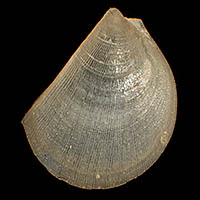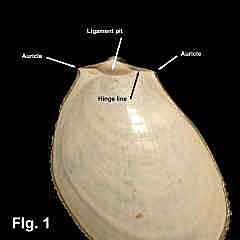|
< Previous family introduction |
|
 |
Family Limidae File Shells
|
|
The Limidae, commonly known as file shells, are of elongate or elongate-oblique shape with radial ribbing, with the hinge extended laterally into auricles (Fig. 1). It is a large family, with at least 250 species. The family occurs worldwide, most commonly intertidally and in the shallow subtidal, but a few species live in deeper water. Some live attached by a byssus, and some construct a ‘nest’ of byssal fibres. A few are free-swimming, moving by rapidly opening and closing the valves. As with other bivalves, they live by filtering microscopic particles from the water. There are 10 species listed here as occurring in NSW. Three of these are relatively large and fairly common – Lima nimbifer, Limatula strangei and Limaria orientalis - and they occur commonly alive on rocky shores and in beach washup as empty shells. The other species are smaller and occur in deeper water. They range in size from 15 mm down to 3.5 mm in height. In habitat, several extend down to 200 or 300 m depth, and one, Limea australis, occurs at 366 - 1097 m depth. The family has been catalogued in Australia by Lamprell & Whitehead (1992), but there have been some changes in names since that treatment. C.A. Fleming (1978) reviewed the genus Limatula as a whole and named some new species. The family was reviewed by J.R. Stuardo in an unpublished Ph.D. thesis in 1968 in which he provided many new names, including for the species referred to here as Limaria orientalis. Stuardo’s names were accepted by Huber (2010), but they are not accepted here as they do not meet the requirements set out in the rules in International Code of Zoological Nomenclature for publication. Family Reference Fleming, C.A. 1978. The bivalve mollusc genus Limatula: A list of described species and a review of living and fossil species in the southwest Pacific. Journal of the Royal Society of New Zealand 8(1): 17-91. Coverage All NSW species are treated here. Identification Notes Some of the characters used for identification are shown in Fig. 1. There are auricles at both ends of the dorsal margin, below which the margin may be curved inwards (as in Limatula iredalei) or not curved in (as in Limatula powelli). The ligament is attached in a triangular pit, narrow or wide, immediately below the umbo. Fig. 1 Shell terminology Additional Species Limatula jacksonensis (Thiele, 1920) This species is similar to Limatula powelli, but has stronger sculpture, consisting of about 20 radial ribs. Specimens were recognised from NSW by C.A. Fleming (1978) from one lot from 22 miles (35 km) east of Narrabeen, but he said they were too badly worn to allow exact comparison or illustration. Examination of the specimens by the current author confirms that assessment. Limatula ponderi C.A. Fleming, 1978 This species is apparently similar to L. iredalei, but is larger, reaching up to 28 mm. It is known from off Rockhampton, Queensland, southwards to Tweed Heads at the Qld-NSW border. Fleming (1978) reported it from NSW from one lot (C.26067, reregistered as C.398861) from 22 miles (35 km) east of Narrabeen, in 146 m but examination of the specimens by the author shows them not to be this species. Limaria fragilis (Gmelin, 1791) This species is common on coral reefs in the tropical Indo-Pacific Ocean and it extends to southern Queensland where it is reasonably common offshore. A single shell valve was collected on the reef platform on the southern side of Hastings Point, NSW.
|
